Services on Demand
Journal
Article
Indicators
-
 Cited by SciELO
Cited by SciELO -
 Access statistics
Access statistics
Related links
-
 Cited by Google
Cited by Google -
 Similars in
SciELO
Similars in
SciELO -
 Similars in Google
Similars in Google
Share
Profile: Issues in Teachers' Professional Development.
Print version ISSN 1657-0790On-line version ISSN 2256-5760
profile no.9 Bogotá Jan./June 2008
Developing Cognitive Processes in Teenagers through the Reading of Short Stories*
Desarrollo de procesos cognitivos en adolescentes a través de la lectura de historias cortas
Adriana Norato Peña** Jeny Mirella Cañón***
IPARM School, Universidad Nacional de Colombia ** E-mail: amnoratop@unal.edu.co *** E-mail: jmcanonl@unal.edu.co
This research-innovation project aims at developing cognitive processes explicitly through the reading of short stories. It is based on reading strategies and Bloom’s cognitive domain (1981) which was applied in the English classes we had with sixth graders at IPARM (Instituto Pedagógico Arturo Ramírez Montufar) School at Universidad Nacional de Colombia, in Bogotá. The six categories (knowledge, comprehension, application, analysis, synthesis and evaluation) of Bloom’s cognitive domain were worked with reading activities. In order to develop our students’ cognitive processes and their English language learning skills, it was first necessary to involve them in reading for pleasure. The findings are the result of triangulated data collected through teachers’ journals, direct observation, and students’ artifacts and show the evidence of the significant improvement students have made in their English language learning skills and cognitive processes.
Key words: Cognitive processes, reading strategies, Bloom’s taxonomy, English language learning skills
Este proyecto de investigación e innovación buscó desarrollar los procesos cognitivos de manera explícita a través de la lectura de historias cortas. Se basa en las estrategias de lectura y el dominio cognitivo de Bloom (1981) aplicados en clases de inglés con estudiantes de sexto grado del colegio IPARM de la Universidad Nacional, Sede Bogotá. Las seis categorías del dominio cognitivo de Bloom (conocimiento, comprensión, aplicación, análisis, síntesis y evaluación) se trabajaron usando actividades de lectura. Para iniciar el trabajo de desarrollo de procesos cognitivos y de habilidades de aprendizaje de inglés, fue necesario comenzar a leer por placer. Los hallazgos –luego de la triangulación de datos a través del diario de las profesoras, la observación y los trabajos elaborados por los estudiantes– evidencian un mejoramiento significativo en el desarrollo de procesos cognitivos y, en general, en las habilidades de aprendizaje de inglés como lengua extranjera.
Palabras clave: Procesos cognitivos, estrategias de lectura, taxonomía de Bloom, habilidades de aprendizaje de inglés
Introduction
Children’s difficulties have caught our attention because during our experience as teachers we have noticed that students usually to show a low English level in their communicative production and comprehension.
This paper reports our experience as helpers and facilitators of a group of sixth graders who was developing cognitive processes and English language skills simultaneously. We hope that it invites you to reflect upon your teaching practice and challenges you to design classes that correspond with your students’ interests, needs and context.
The research questions addressed in the qualitative research we conducted with sixth graders were as follows:
How can teenagers’ cognitive processes be developed in the English class?
How can reading strategies help to develop the cognitive processes in teenagers? The following sections include a brief review of the relevant literature, methodology, findings and conclusions.
Review of Literature
Learning a language is much easier by exposing learners to a variety of meaningful experiences in which they use language as well as express and share thoughts to create and re-create knowledge. In this respect, we consider three main aspects for our project: first of all, the cognitive aspect that is related to adolescents’ characteristics; second, reading activities; and finally, Bloom’s taxonomy with its six categories (Bloom, 1981).
Piaget proposes three stages, mentioned by Brewster (1991): ‘the sensori-motor’ (birth to 18 moths approximately), ‘concrete operational’ (18 months to 11 years approximately), and ‘formal operations’ (11 years onwards). In this report we consider the last two stages, ‘concrete operational’ (18 months to 11 years approximately) and ‘formal operations’ (11 years onwards). The ‘concrete operational’ is subdivided into two further periods: ‘the pre-operational’, which lasts until around the age of seven, during which the ‘concrete operations’ are being prepared for; and ‘the operational’ period, during which they are established and consolidated. The ‘operational’ period and the ‘formal operations’ are taken into account in this project since all our students belong to this age range where they ‘begin’ to reason logically and organize thoughts coherently.
In addition to adolescents’ cognitive development, it is important to keep in mind some aspects related to cognitive processes; those are the processes involved in building knowledge.
Although the thought process has been recognized as complex, there was no uniformly accepted way of describing the complexity until Benjamin Bloom succeeded in classifying the thought process into six very dynamic levels. These levels increase in complexity, from knowledge as the baseline level, through comprehension, application, analysis, synthesis, to evaluation as the highest level. This classification is referred to as the “Cognitive Domain of Bloom’s Taxonomy of Educational Objectives” (Nkanginieme, 1997, p.1).
There are other domains, “Affective” and “Psycho-motor”. The first one embraces the emotional feelings associated with thought processes, and the second one refers to the correctness of skill performance; but for our purpose, we will focus only on the cognitive domain. Table 1 outlines each level of cognition along with operative words illustrating the type of thought activity the level describes, as found in Nkanginieme (1997, p. 1-2).
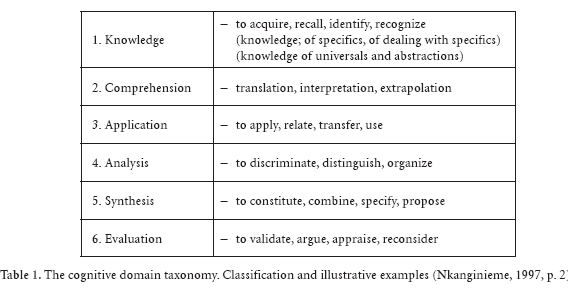
Bloom (1981) classifies the cognitive process into six levels of increasing complexity. It goes from knowledge as the basic level, through comprehension, application, analysis and synthesis, to evaluation at the highest level. The importance of this classification lies in how it helped us to encourage meta-cognition in our students’ learning processes. It means that the most “sub-conscious” thoughts can be brought to “consciousness” and thus they become more teachable.
The Reading Process
Reading and writing can be seen as important mechanisms in cognitive changes, and in the building and transmission of knowledge. Reading and writing cannot be considered as natural in children’s development. They are cultural products that are learned not only through interacting with others, but also through formal teaching and learning processes.
Nowadays, there is an agreement in considering reading and writing as cognitive skills that include complex strategies with lots of psychological processes integrated. Thus, this project will be focused on reading as the baseline for working on different language skills and for developing cognitive processes based on Bloom’s categories.
Reading is defined as the process between decoding written / graphical series and understanding of meaning. Writing can be defined as processes of communication that generates feelings, knowledge and structural thinking. These processes depend on the coordination of our information systems (visual, aural, motor, linguistic, and conceptual, among others), that are developed since our childhood and our thinking (Domínguez, 1988).
In our project, therefore, we took into account the idea of having reading as a cognitive process that refers not only to decoding but also understanding a text. Understanding is defined as having knowledge about a subject, situation, or about how something works (Cambridge Advanced Learner’s Dictionary, 2004). In this project, understanding is understood as having knowledge and comprehension of a text, mainly through one of the strategies proposed to develop reading comprehension: the use of questions words like Who? Why? What? Understanding is thus fostered through a type of question that, according to González, “creates a propitious environment to develop the skills of comprehension and communication”.1
Methodology
This study was conducted at the IPARM School, Instituto Pedagógico Arturo Ramírez Montufar in Bogotá, Colombia, from July to November 2006. It is descriptive in nature and is concerned with exploring, understanding and analysing sixth graders’ English learning (Burns, 1999; Markeee, 1997). The project is an innovation and research project because it involves cognitive processes in ELT, a topic that has not been researched in our school site. Students’ improvement was expected to be in terms of their level of analysis and interpretation of situations presented in short stories read in English.
Participants
The participants in this study were a group of sixth graders and the two teachers who were researchers–observers. There were 36 sixth graders, with 70% of the students having obtained their parents’ permission to participate in the project. Sixth graders customarily received three hours of English instruction per week.
There were 8 students with a high level of English. On the one hand, that situation really helped in group work since it enriched the kind of work done by the group but, on the other hand, there were obvious reading comprehension difficulties in the low-achievers. This was manifested not only when dealing with unknown words and expressions (literal reading), but also when trying to understand a text (comprehensive reading) (Grellet, 1981). Consequently, it was necessary to work on reading comprehension and English learning at the same time. In order to achieve this, it was intended to motivate, to have different type of exercises, and also to work on different skills.
Students participating in this study were eleven to twelve years old. They were able to write simple sentences and short paragraphs. They behaved well and, in general, had good study habits. They were very motivated and interested in learning English. They were very enthusiastic and participative.
Pedagogical Procedure
During the project we implemented reading comprehension strategies to develop cognitive processes in teenagers. First, it was necessary to motivate students to read for pleasure by exposing them to English reading in order to build their cognitive processes and, also as a way to learn different aspects of the language. To do it, students chose a book called ‘Ghastly Ghosts’ (see picture 1), a compilation of different ghost stories.
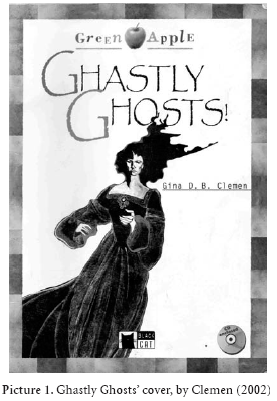
To start the project, we decided to work on six classes of one hour and a half. In each class, some workshops were developed (See sample in Appendix 1). Workshops included a planning phase, an implementation phase and an evaluation phase.
In each class, we intended to have some silent and oral reading moments (Topping, 1989), either in groups or individually.
Then, there were periods of open questions to elicit the general sense of the text, and to have students’ opinions about what the author’s intention was. After that, there were some activities to identify unknown vocabulary, expressions and words. It helped us in improving students’ understanding of the text so they could show understanding through actions like drawing, miming and acting out, among others. Besides, games helped us to work more in the interpretation of the text and the contexts found in the reading.
Data Collection
The data collection, as such, took place during the third term of the year –from July to October, 2006. We decided to collect data by using three basic techniques:
observation, journal, and students’ artifacts. We also used some photos and videos to support observation.
At first, we started looking at the data sources individually. Then, we compared and analyzed the information keeping in mind that “The analysis must try to give sense to the data by explaining what is happening in the real context of the classroom, and it should attempt to identify some patterns and categories… Doing analysis is, in fact, making interpretations” (Jiménez et al., 1995, p. 19).
We wrote a journal during each class. Most of the time one of us taught the lesson and the other observed it. There were some classes both of us taught, taking turns to explain or supervise the activities done. The observer took notes and the teacher of the class wrote a journal. At the end of the lesson, we shared the information gathered in the journal, as can be seen in Chart 1. We also discussed a bit more the situations presented in the class, the activities done and some other aspects related to the teaching-learning processes. Observation and writing journals helped us to collect information about students’ attitudes and reactions towards the activities proposed and, they also helped us in evaluating students’ participation and progress. In addition, these ways of collecting data gave us the opportunity to reflect on and rethink our teaching practice and the effectiveness of the lessons plans we designed.
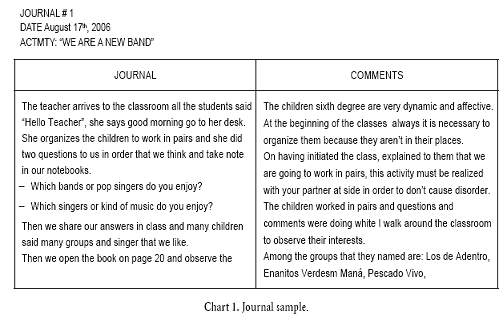
Students’ artifacts were mainly compared with those which students had before or had at the beginning of the project. Some of the artifacts used were posters, drawings, short stories, homework, etc. Students’ artifacts were very useful to check their improvement and reactions; first, in terms of their motivation and participation in the class and, then, in their response to the activities proposed to develop different levels of cognitive processes, as can be seen in Pictures 3 to 6. We think it is important to clarify that collaborative work was a tool in the class to check students’ progress as both low achievers and advanced students were able to participate actively in class. The following chart shows the analysis of an artifact done in class.
Other ways to gathered information were video recordings and photographs. Video recordings were not done in all the classes. We recorded only activities related to reading strategies (Topping, 1989) such as making predictions about the story, doing word webs (see Picture 2), reading silently while listening, and acting out the story, among others. Photographs were used to capture some important moments like cooperative work (see Picture 3), and students’ productions as it seen in Pictures 4 and 5.
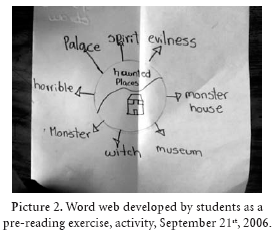
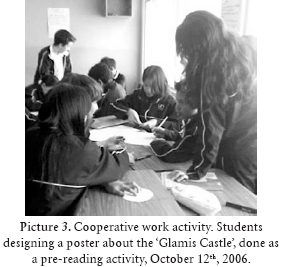
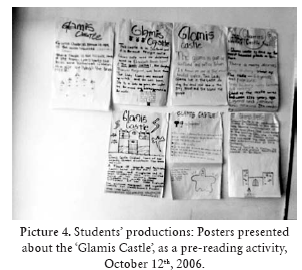
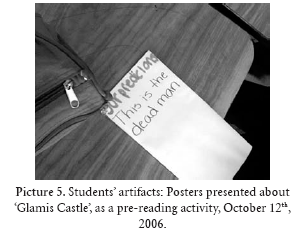
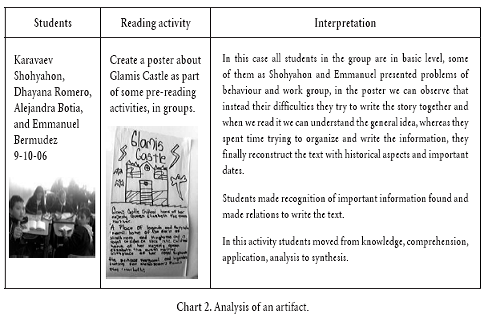
After having more information gathered, we started to compare and analyze the type of information obtained (see Table 2).
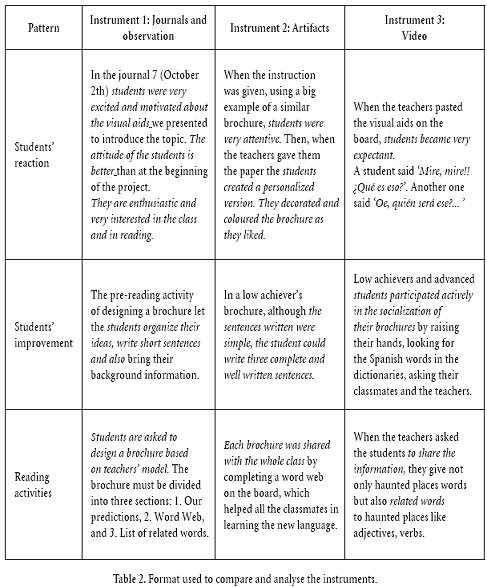
Findings
The triangulation of teachers’ journals, direct observation, and students’ artifacts as research resources provided us with valuable information that allowed us to identify the following categories and subcategories that emerged: Cognitive processes, reading and action!, Making English together!, and Better is always possible!
Cognitive Processes, Reading and Action!
This research feature refers to English reading activities which suggest that students are able to respond to higher thinking level activities. An example of this can be seen in the October 5th class in which students had to act out their own interpretation of the story in groups of seven. Most of the groups included additional information that really helped the class to understand the performance and also to evaluate it. There were different options students used to adapt the story ‘The Horror of Berkeley Square’.
The following chart illustrates the journal analysis, taking Bloom’s taxonomy as a starting point.
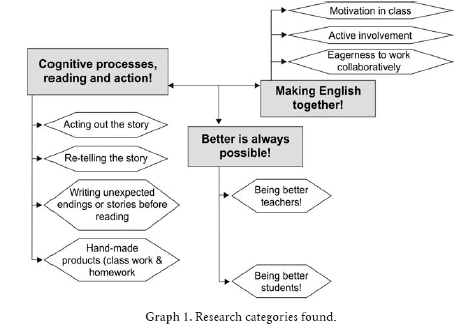
Making English Together!
This research feature is referred to students’ reactions towards English reading activities and class. We have found two classes that can be considered as examples of this feature. One was on September 21st, in which students had to make predictions, create a word web about haunted places and make a list of vocabulary in pairs. Then, they were asked to share the information with the class. In this case, we could observe a higher commitment in doing the activity as they had to work in pairs and then with the class. All of them seemed to be very interested and motivated in the topic. Some of them looked up new words in the dictionary; some others just tried to remember previous vocabulary and some even used words in Spanish. All the students worked cooperatively to create a good class work. They also participated actively in the class. Evidence can be found in the pictures below.
Pictures taken on September 21st, 2006 based on the story ‘The Horror of Berkeley Square.’
Another example of the research feature referring to the students’ reactions was an activity done on October 9th, in which students had to make a poster based on the information each student found at home.
It was a pre-reading activity. Students were more conscious of the reading activity developed in class. In the pictures below, students’ motivation, involvement and cooperative work are clearly seen.
In that class, students also presented the poster to the class. Although there were no specific requirements for the presentation, all the group members decided to participate by presenting or reading.
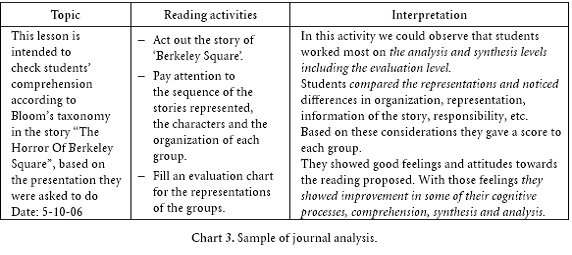
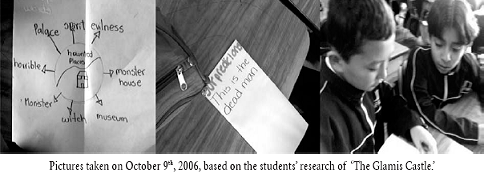
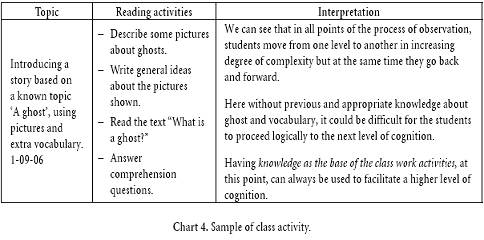
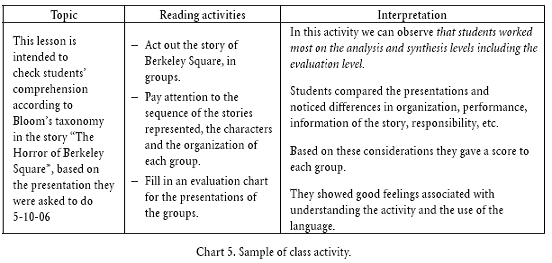
Better is Always Possible!
This research feature refers to students’ and teachers’ improvement in the English class. Students showed a better performance in solving more complex reading activities, evidence of understanding a text and increased language learning and more fluent participation in written and oral activities.
In the following charts, there are class descriptions that show how students were moving more freely from knowledge to synthesis, according to their classwork.
Teachers became facilitators in language learning through reading in their classes, as they were giving and receiving information to build daily lessons. We used more appropriate learning strategies in class such as creating sample materials, keeping in mind students’ interests and levels, among others. We also developed classes integrating skills as shown in the previous pictures, samples and charts, where you can find class descriptions and reading activities that include acting out the story, predicting, retelling a story, making writing attempts, interpreting images, attending and taking part in acts of reading.
Conclusions
The development of cognitive processes in teenagers is possible when there is a syllabus that allows the teacher to develop different types of thinking activities in which students can build up creativity, use their background information, and work cooperatively. This is also possible if they are engaged in activities in which they can rethink their English language learning, integrating efficiently their cognitive processes and the development of the four skills.
In this project, we decided to employ reading strategies that can be worked with Bloom’s taxonomy and its cognitive domain. Reading strategies (Topping, 1989) have been one of the sources to develop thinking operations. In others words, through reading students learn not only the language, as such, but also contextualized situations that help them build relationships among different aspects related to real life, their experiences, their previous knowledge, and others. Reading strategies have helped students in learning more easily and meaningfully as they are always prepared to face a text.
This project has not only influenced our sixth graders, it has also impacted other students from different grades and English levels at school. Parents are even more involved in their children’s English learning process.
Students also had the chance to improve their learning process through different activities. They realized that they had abilities and background information to communicate their ideas in English. Besides that, students noticed that communicating in English could be done not only with words but also by using their whole body to convey meaning.
Reading is a great excuse to develop high level processes of thinking skills by applying Bloom’s cognitive domain (1981), since in the process of reading, one can work explicitly all these categories by using different reading strategies that allow students to move from knowledge to evaluation categories.
As teachers, we can say that developing cognitive processes explicitly has let us realize the richness our students have to offer. Reading at early ages is not as difficult as we used to think. It has been a useful tool to develop not only cognitive processes and skills, but also higher motivation and a better environment in the English class.
Pedagogical Impact
All the members of the community have been impacted by this project. First, not only our sixth grade students were influenced, but other students from different grades and English levels were affected by the implementation of this project. On the one hand, low achievers have shown a bigger progress in their English level and realized that they were able to face and succeed in English activities without failing. On the other hand, advanced students reinforced their oral and written skills and, also, their group work abilities. As a result, students from different levels were able to work cooperatively without having their English level act as a barrier in their communication.
Second, this project has opened a homeschool connection because there was better communication among parents, their children and the teachers. Parents were more involved in their children’s English learning. Parents showed more interest in their children’s learning as they saw the great change most of them revealed in their motivation and in their English language command. Parents were always eager to participate and help in the activities proposed, and they were always informed and ready to give suggestions and comments to improve the process.
Finally, this project impacted administrators and colleagues. Administrators were always open to help us with materials and other resources. Our colleagues showed a great interest in the project implementation in all the grades for next year. It is because they saw students’ positive change and progress in learning as well as in motivation and attitude towards the English class.
Recommendations
The development of cognitive processes needs to be carefully planned, and special materials are not necessary. One can adapt different types of topics not only from English culture, but also from our culture or other fields of knowledge like social science, literature, among others. The readings and the reading strategies to be used should be selected according to students’ interests and cognitive development. In addition, it is also necessary to integrate all the skills when the lesson is planned.
A way to involve our students more is by using materials designed by the teachers. Those materials should be colourful, attractive and extensively used. They have to be helped by other sources like Internet, visual aids, listening and others related to the topic proposed. Therefore, the short stories used are not only the tool but the media to have students work cooperatively on a topic they like, hence, developing high level thinking processes. Finally, it is necessary to socialize the project in the school site to give colleagues the chance to learn how to use and take advantage of Bloom’s taxonomy (1981) so they can be part of the project in the near future.
* This paper reports on a study conducted by the authors while participating in the PROFILE Teacher Development Programme, at Universidad Nacional de Colombia, in 2006. The programme was sponsored by Secretaría de Educación de Bogotá, D.C. Code number: 30101007234.
1 Information provided by the teacher educator Lilia Esther González, in the PROFILE Teacher Development Programme, at Universidad Nacional de Colombia, in 2006.
References
Bloom, B. (1981). Taxonomía de los objetivos de la Educación: la clasificación de las metas educacionales: Manuales I y II. Translation of Taxonomy of educational objectives; the classification of educational goals. Madrid: El Ateneo. [ Links ]
Brewster, J. (1991). What is good primary practice? In Brumfit, J., Moon, J., & Tongue, J. (Eds.). Teaching English to Children, from practice to principle. London: Harper Collins Publishers. [ Links ]
Brumfit, C., Moon, J., & Tongue, J., et al. (1991). Teaching English to children, from practice to principle. London: Harper Collins Publishers. [ Links ]
Burns, A. (1999). Collaborative action research for English language teachers. Cambridge: Cambridge University Press. [ Links ]
Cambridge Advanced Learner’s Dictionary. (2004). Cambridge: Cambridge University Press. [ Links ]
Clemen, G. (2002). Ghastly ghosts. Barcelona: Black Cat Publishing. Vicens Vives S.A.
Domínguez, P. (1988). Aspecto dinámico de la escritura. En J. García Padrino & A. González, (2006). Conference about ‘The Glad’ Project. Second PROFILE Symposium. Bogotá: Universidad Nacional de Colombia. [ Links ]
Grellet, F. (1981). Developing Reading Skills. Cambridge: Cambridge University Press. [ Links ]
Jiménez, S., Luna, M., & Otálora, M. (1995). COFE Series: Action Research Guide. Bogotá: COFE Project. [ Links ]
Markeee, N. (1997). Managing curricular innovation. Cambridge: Cambridge University Press. [ Links ]
Nkanginieme, K. (1997). Clinical diagnosis as a dynamic cognitive process: Application of Bloom’s taxonomy for educational objectives in the cognitive domain. Med Educ Online [serial online]; 2:1. Retrieved on September 2006 from http://www.med-ed-online.org/f0000007.htm#f0000007 [ Links ]
Topping, K. (1989). Lectura conjunta: una poderosa técnica al servicio de los padres. Comunicación, Lenguaje y educación. 3-4, 143-151. Retrieved on September 2006, from http://www.ucm.es/BUCM/compludoc/S/10403/02147033_3.htm [ Links ]














